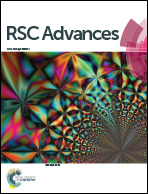TEMPO-mediated oxidized nanocellulose incorporating with its derivatives of carbon dots for luminescent hybrid films†
Abstract
The first use of nanocellulose extracted from bamboo fibers as a fibrous network skeleton and carbon dots derived from nanocellulose as guest fluorescent nanomaterials to construct a transparent, photoluminescent hybrid film is reported. The primary hydroxyls of nanocellulose are firstly converted to the carboxyl form by using tetramethyl-1-piperidinyloxy (TEMPO)-mediated oxidation to enhance the interfacial interaction with carbon dots and then to assemble heterogeneous network architectures through covalent bonding. The carbon dots derived from TEMPO-mediated oxidized nanocellulose display highly uniform spherical morphology with a narrow size distribution ranging from 6 nm to 11 nm. The resultant nanocellulose-based hybrid film has high transparency in bright field imaging and a strong blue luminescence under ultraviolet excitation. Furthermore, the biocompatible hybrid film extracted from the biomass exhibits excellent thermal stability and outstanding mechanical durability, which could be utilized as a substitute for petroleum-based film for diverse applications.


 Please wait while we load your content...
Please wait while we load your content...